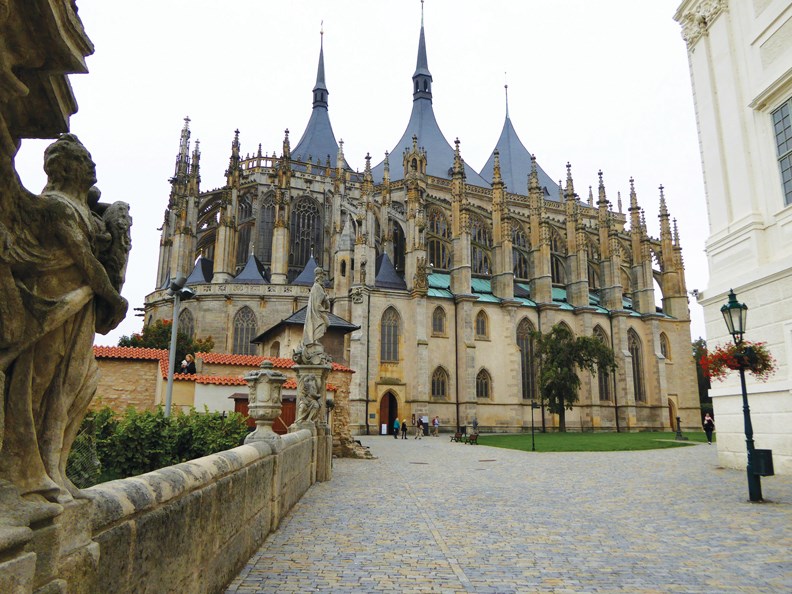Our Viking Cruise extension in Prague enables a remarkable day trip to World Heritage Kutna Hora, 85-kilometres away.
Outside the gate of Sedlec Ossuary stands a marble statue of the Czechs’ beloved Saint John. A golden halo with five stars circles his head. We walk onward between flower-adorned gravesites.
“A monk sprinkled earth brought from Christ’s crucifixion site around this cemetery, popularizing burial plots. Plagues and wars created demands for more space,” guide Rita recounts. “That baroque church was built with an ossuary, providing eventual storage for over 40,000 skeletons.”
Inside the lower chapel, mounds of skulls occupy every corner.
“A half-blind monk began stacking bones here in the 16th century,” Rita notes. “Three centuries later, the Schwarzenberg family employed woodcarver Frantisek Rint to arrange the human remains as tributes to lives well spent, commonly done in other ossuaries.”
Small bones spell out Rint’s name near the entrance. Garlands of skulls, ulnae and tibia drape the chapel’s vault. Other skeletal arrays form startling crucifixes. Among the chapel’s decorations and furnishings, an enormous chandelier of bones hangs from the centre of the nave. Every bone in the human body is represented in this astonishing light fixture. A large glass case exhibits the House of Schwarzenberg’s coat of arms. Swirling clavicles create the upper crown. Below this emblem of royalty, a raven skeleton pecks at a human skull.
Just beyond, we visit gothic-styled Santa Barbara church. Rita explains how silver miners began financing its construction in 1388. The decreasing mine productivity and evolving plans interrupted completion. The three pointed black slate roofs now featuring gilded crosses enclosed the original 1588 structure. Double-arched flying buttresses supported a later expansion, which provided seating space for the clergy and choir. Jesuits later added baroque adornment.
Gargoyles stare down at us from this striking architecture. Finished at the end of the 19th century, recent laser treatment restored the stonework’s honey-hued glow. Unscathed by war, the cathedral-like church is a monument to a town whose wealth was originally based on mining.
Inside, gilded confes-sionals and choir stalls line the walls. Intricately carved altars and pulpits rise in the centre. One large fresco shows the child Jesus riding on Saint Christopher’s shoulders.
The stained glass windows present regional themes, often reflecting Kutna Hora’s past. Our guide points out one notable exception depicting Saint Barbara. The tower where her father locked her up appears in the background. We learn she became Christian, defying her pagan father. Miraculously escaping initial punishments, he ultimately beheaded her. Retaliating, God struck him down with lightning. She aptly became the patron saint of miners, who use explosives. Honouring her, the miners named the church Santa Barbara.
Interior décor repeatedly recognizes these hard-working benefactors. We first note a statue of a white-robed silver miner standing between two marble saints. In the Mint Chapel, a fresco portrays miners using a winch in excavations and merchants purchasing ores. In another, miners pound out molded thalers with mallets.
“The term ‘dollars’ derived from these silver coins,” Rita notes.
From the church, we stroll on a long promenade beside a red-roofed 17th century Jesuit college. Admiring sculptures atop its stone wall and vistas of the green countryside beyond, we continue into old town. Stopping at an outdoor bar, most of us sip newly vinted white wine. This local effervescent Burcak proves refreshing.
Heading onward along winding cobblestone streets, we view numerous homes and businesses still adorned with sgrafitti (bi-coloured etchings) and paintings of medieval scenes. Ensconced in an old inn, we savour thick spicy goulash and local beer while chatting with shipmates about our sensational experiences in the Czech Republic.



